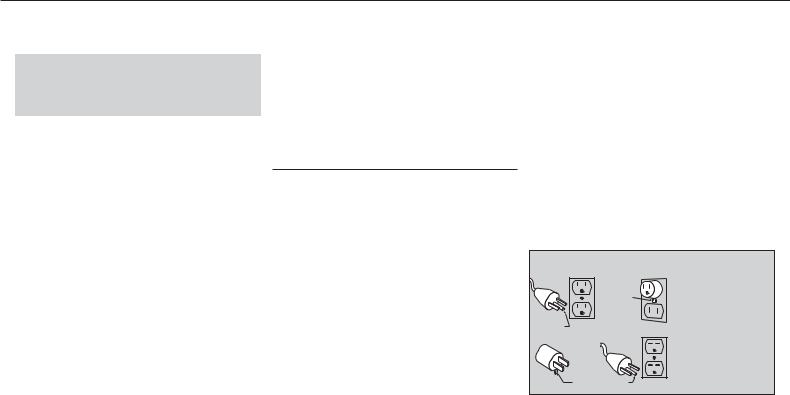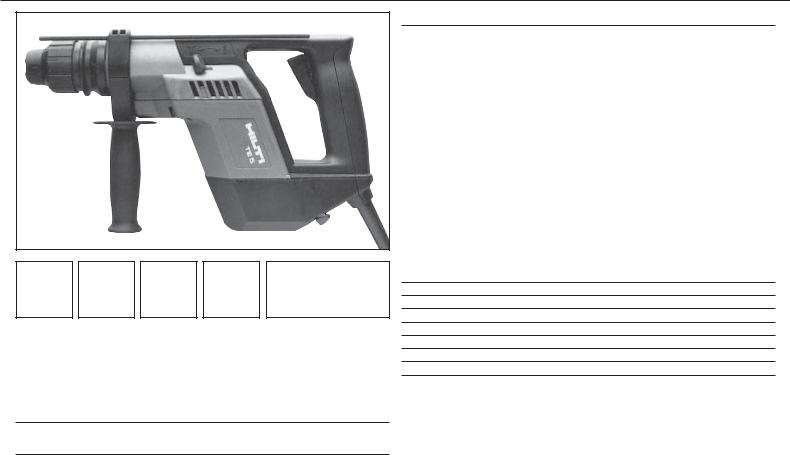Hilti TE 5, TE 5-DRS User Manual

*201315* |
Operating instructions TE 5 / TE 5-DRS |
201315 |
Rotary Hammer Drill
3-Wire Grounded Construction
Printed: 07.07.2013 | Doc-Nr: PUB / 5071017 / 000 / 00

Safety precautions for 3 wire grounded construction
WARNING:
When using electric tools, basic safety precautions should always be followed to reduce the risk of fire, electric shock, and personal injury, including the following:
Read all instructions
1.Keep Work Area Clean. Cluttered areas and benches invite injuries.
2.Consider Work Area Environment. Don’t expose power tools to rain. Don’t use power tools in damp or wet locations. Keep work area well lit. Do not use tool in presence of flammable liquids or gases.
3.Guard Against Electric Shock. Prevent body contact with grounded surfaces. For example; pipes, radiators, ranges, refrigerator enclosures.
4.Keep Children Away. Do not let visitors contact tool or extension cord. All visitors should be kept away from work area.
5.Store Idle Tools. When not in use, tools should be stored in dry, and high or locked-up place – out of reach of children.
6.Don’t Force Tool. It will do the job better and safer at the rate for which it was intended.
7.Use Right Tool. Don’t force small tool or attachment to do the job of a heavy-duty tool. Don’t use tool for purpose not intended – for example – don’t use circular saw for cutting tree limbs or logs.
8.Dress Properly. Do not wear loose clothing or jewelry. They can be caught in moving parts. Rubber gloves and non-skid footwear are recommended when working outdoors. Wear protective hair covering to contain long hair.
9.Use Safety Glasses. Also use face or dust mask if cutting operation is dusty.
10.Don’t Abuse Cord. Never carry tool by cord or yank it to disconnect from receptacle. Keep cord from heat, oil, and sharp edges.
11.Secure Work. Use clamps or a vise to hold work. It’s safer than using your hand and it frees both hands to operate tool.
12.Don’t Overreach / Maintain Control. Keep proper footing and balance at all times.
13.Maintain Tools With Care. Keep tools sharp and clean for better and safer performance. Follow instructions for lubricating and changing accessories. Inspect tool cords periodically and if damaged, have repaired by authorized service facility. Inspect extension cords periodically and replace if damaged. Keep handles dry, clean, and free from oil and grease.
14.Disconnect Tools. When not in use, before servicing and when changing accessories, such as blades, bits, cutters.
15.Remove Adjusting Keys and Wrenches. Form habit of checking to see that keys and adjusting wrenches are removed from tool before turning it on.
16.Avoid Unintentional Starting. Don’t carry tool with finger on switch. Be sure switch is off when plugging in.
16A. Extension Cords. Make sure your extension cord is in good condition. When using an extension cord, be sure to use one heavy enough to carry the current your product will draw. An undersized cord will cause a drop in line voltage resulting in loss of power and overheating. The following table shows the correct size to use depending on cord length and nameplate ampere rating. If in doubt, use the next heavier gage. The smaller the gage number, the heavler the cord.
Extension Cord Table
Volts |
|
Total Length of Cord in Feet |
|
|||
120 V |
|
0–25 |
26– 50 |
51–100 |
101–150 |
|
240 V |
|
0–50 |
51–100 |
101–200 |
201–300 |
|
Ampere Rating |
AWG |
|
|
|
||
More Than |
Not More Than |
|
|
|
|
|
|
0 |
6 |
18 |
16 |
16 |
14 |
|
6 |
10 |
18 |
16 |
14 |
12 |
|
10 |
12 |
16 |
16 |
14 |
12 |
12 |
16 |
14 |
12 |
Not recommended |
||
17.Outdoor Use Extension Cords. When tool is used outdoors, use only extension cords intended for use outdoors and so marked.
18.Stay Alert. Watch what you are doing. Use common sense. Do not operate tool when you are tired.
19.Check Damaged Parts. Before further use of the tool, a guard or other part that is damaged should be carefully checked to determine that it will operate properly and perform its intended function. Check for alignment of moving parts, binding of moving parts, breakage of parts, mounting, and any other conditions that may affect its operation. A guard or other part that is damaged should be properly repaired or replaced by an authorized service center unless otherwise indicated elsewhere in this instruction manual. Have defective switches replaced by authorized service center. Do not use tool if switch does not turn it on and off.
20.Only use accessories and attachments which are given in the operating instructions or in the respective catalogue. The use of accessories or insert tools or attachments other than those specified in the operating instructions can result in personal injury to you.
21.Only have repairs carried out by recognized electrical specialists. This electric tool/machine complies with respective safety
regulations. Repairs may only be carried out by an electrical specialist otherwise an accident hazard for the operator can exist.
22.Wear ear protectors when using for extended periods.
23.Always use any supplied side handle, and keep it tightly secured; use both hands during operation. Keep proper footing and balance and don’t overreach. Firm control of the tool is necessary should the tool bind.
24.Hold Tool by Handle(s) Provided. Do not touch uninsulated parts of tool when drilling. Exposed metal surfaces may be made live if the tool drills into electrical wiring.
25.Grounding instructions. This tool should be grounded while in use to protect the operator from electric shock. The tool is equipped with a 3-conductor cord and 3-prong grounding type plug to fit the proper grounding type receptacle. The green (or green and yellow) conductor in the cord is the grounding wire. Never connect the green (or green and yellow) wire to a live terminal. If your unit is for use on less than 150 V, it has a plug that looks like that shown in sketch (A) in Figure «Grounding Methods». If it is for use on 150 to 250 V, it has a plug that looks like that shown in sketch (D). An adapter, see sketches (B) and (C), is available for connecting sketch (A) type plugs to 2-prong receptacles. The green-colored rigid ear, lug, or the like, extending from the adapter must be connected in a permanent ground, such as a properly grounded outlet box. No adapter is available for a plug as shown in sketch (D).
GROUNDING METHODS
metal screw
cover of grounded  outlet box
outlet box 
grounding pin |
(A) |
(B) |
|
|
grounding |
|
|
(C) |
means |
grounding pin |
(D) |
26. Extension Cords. Use only 3-wire extension cords that have 3-prong grounding-type plugs and 3-pole receptacles that accept the tool’s plug. Replace or repair damaged cords.
Please read and take note of these precautions before you use the tool/machine and always keep this safety precautions with the tool.
SAVE THESE INSTRUCTIONS
Printed: 07.07.2013 | Doc-Nr: PUB / 5071017 / 000 / 00

Hilti TE 5 Rotary Hammer
This Product is Listed by Underwriters
Laboratories Inc. and bears the Mark:
Always wear ear |
|
Always wear pro- |
|
Always wear safety |
|
Protective earthing |
protectors. |
|
tective gloves. |
|
glasses. |
|
|
|
|
|
|
|
|
|
|
|
|
|
|
|
|
Accessories and kit for Hilti TE5 rotary hammer:
Hilti lubricant spray, TE 5-DRS dust removal system, key-type chuck, quickrelease chuck case or cardboard box
Before starting to work, please read the enclosed safety precautions.
Technical data
Power input: |
500 W |
Voltage: |
115 V |
Current input: |
4.6 A |
Frequency: |
50–60 Hz |
Weight: |
2.8 kg / 6.2 Ibs |
Speed under load: |
0–800 r.p.m. |
Hammering speed under load: |
0–4000 blows per minute |
Single impact energy: |
2.0 joules / 1.5 ft-lb |
Drill bit diameter range: |
5–20 mm (3/16″–3/4″) dia. in concrete |
Recommended range: |
5–10 mm (3/16″–3/8″) dia. |
Drilling performance in B35 concrete: |
8/150 mm (5/16″/6″) dia.= 24 cm3/min. |
|
(1.46 in.3) = 480 mm/min. |
Drill bits in standard programme: |
|
TE-C drill bits |
4–16 mm (5/32″–5/8″) dia. |
TE-C-S drill bits |
18 mm / 20 mm (5/8″/3/4″) dia. |
TE-C-HB forming bit |
10–24 mm (3/8″–1″) dia. |
Chuck |
TE-C |
Carbon brushes with automatic cut-out |
|
Protection class I (grounded tool) |
|
Slip-type clutch as protection against motor overloading
Sealed against dust, permanent lubrication (maintenance free)
Variable speed control switch with infinite regulation
Reversing switch
Adjustable side handle with depth gauge
Automatic hammering cut-out when idling
Setting lever for hammer drilling/rotary drilling only
Connections for dust removal system
Right of technical modifications reserved.
Please refer to the respective regulations of your trade association and the enclosed safety precautions!
Printed: 07.07.2013 | Doc-Nr: PUB / 5071017 / 000 / 00
